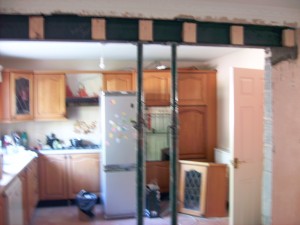How to remove a load-bearing wall will show you the step-by-step process of removing a wall to achieve an open floor plan in your own home. People love the idea that they can be in different areas and yet still enjoy each other’s company. You don’t have to invest in a new home to benefit from having an open floor plan. You can remove walls in your existing home to create your own open floor plan that perfectly suits your style. However, removing load-bearing walls must be done with the greatest care. Here are some things to keep in mind before you take out the sledgehammer and start tearing down walls.
How to remove a load-bearing wall
Consult with a structural engineer and the City
Structural walls carry the weight of the house above them. They prevent your roof from sagging and keep the structure from caving in on itself. A structural engineer can advise you on whether a wall is load-bearing or not, and they can advise you on how to replace the support with the wall removed. Steel beams will be required to support the load and transfer the weight to nearby walls. An engineer can advise you on the proper size beam to invest in.
It’s also important to get official permission before you start making major changes to your home. Even though all the work will be inside your home, you may still have to get a permit. Before signing off on the permit, the inspector will ensure that the new support beam is adequate and properly installed. It’s for your protection. When the time comes to sell your home, potential buyers may recognize that the house has been altered based on similar homes in the area. If the work required a permit and you didn’t pull one, it can cause problems with the sale of your home.
Support options for your load-bearing wall
When a wall is removed, a beam will have to replace it. Steel beams are the strongest, and that is what you should opt for whenever possible. However, you can choose attractive columns to support the beam. If you aren’t interested in columns, then you will have to open the end walls and put a new support inside those walls to carry the weight of your new beam. Depending on the space you open up, you may be required to leave one or more support pillars in place. If you only want a small space opened, consider installing French doors to flood the area with light without removing the entire wall.
Preparing the space before removing a wall
Removing a wall of any kind is messy work. There will be sheetrock or plaster dust, and you are sure to encounter a fair amount of stray nails, splinters and other debris. Protect the rooms on both sides of the wall throughout the process by putting drop-cloths in place. Protect furniture with dust sheets, and remove electronics to keep the dust out of them. You will have gaps in the flooring where the old wall was, so this might be a great time to upgrade your flooring to hardwood or natural stone.
Opening the load-bearing wall
One consideration of removing a wall is dealing with electrical lines that are lurking inside. It may be more exciting to use a sawz-all to start cutting the studs apart, but that creates a dangerous situation if there are plumbing or electrical lines inside. Start by opening the sheetrock on one side of the wall and removing it to expose the hardware inside. Depending on your skill set, you may have to call in a plumber and electrician to relocate the lines before you continue work. However, this is an excellent time to add a few outlets, install a ceiling fan or make other upgrades you’ve been considering.
Putting new supports in place
You do not want to damage your home while the old wall is coming down, so you should have the new supports ready to go as the existing wall is removed. Support the overhead structure by setting up scaffold boards on either side of the wall. The boards should run all the way to the ceiling on each side, allowing you to start removing the structure without fear of damaging the property.
Once the old structure is removed, the new support columns should be set in place. Based on the engineer’s guidelines, you may have to install padstones under the new support columns to strengthen the entire structure. It is also vital that you do not exceed the opening that was approved in your consultation. Overloading a beam can lead to serious structural problems and endanger your family. With the help of friends, lift the new beam into place and set it on the support. You can spare your backs and make the project safer by using special house jacks to safely lift the beam into place. With the new beam safely transferred to the support columns and secured, you can start filling in the openings around the beam and fishing off the project.
Removing a load-bearing wall is a serious undertaking. It should not be attempted without consulting with an engineer to confirm the necessary size on your new beam, how many supports it will require and how far it should overhang the supports for proper strength and balance. However, with the right preparation and consideration, you can remove those walls and create the open floor plan of your dreams. As you work, consider other upgrades that fit nicely with the project and will add value to your home.
If you liked ‘How To Remove a Load-Bearing wall, you will enjoy this page of other diy tutorial ideas.
Eric enjoys any type of DIY challenge, whether that is fastening solar panels to a roof or building a new extension. Eric works as a mechanical engineering at Ejot Uk, were he has learn a lot about steel beams and know advises others on DIY Projects in his spare time.







Removing a load-bearing wall could be challenging, that is why you need to consult with the experts, like a structural engineer. A couple of months ago, I have seen on the news about a house renovation gone wrong. They tried removed a load-bearing wall to give way to a bigger bathroom, but the contractor did not know that the bathroom had blocked drain. When they removed the wall, there was a gush of water due to the pressure. It made to the local news, so I think it was quite bad.
Yes, you definitely need a structural engineer (and a couple of visits from your local building regulations’ people if you live in the UK) to remove a load-bearing wall. This is definitely not a DIY job unless you’re an experienced builder. Even so, you’ll still need building regs to sign off on the job after inspection.
We have noticed two cracks in the celing downstairs. They are both above doors but are on two different walls. Nothing huge so we just thought it was normal. Well the home inspectors our buyers got said that the load-bearing wall does not have enough support to hold the weight of the upstairs. They say that the house needs to be jacked up and concrete poured and a beam placed under that wall. This house is only 12 years old. How can a builder not put enough support under a load-bearing wall and get away with it? We are about ready to pull our hair out at the thought of this happening to this home. Any suggestions?
The best course of action is to get a structural engineer in ASAP. Home inspectors won’t really know what’s causing the cracks. a structural engineer will be able to give you sound advice and answer your questions. They will know (based on where the cracks are and what they look like) exactly what’s wrong and what you need to do. Personally, I don’t think you need to jack up the house (in worse-case scenario). You could have builders put a steel beam in place. We had this done to our own house after removing a wall. This seems a better option in my mind.
Recently I removed a wall in my living room in order to make it more spacious and comfortable. The process took 2 complete days but I am happy with the final results. Moreover, you should hire a good professional for the task.
Hi Anne,
It was great reading your post and it is good that you have described everything in your article about removing a load bearing wall.It can be disastrous experimenting with your load bearing wall and it can be quite dangerous to start work without full idea of the work.It is better to pay someone than to get the work done on your own if you do not have a thorough idea about how to go about removing the wall.
Great tutorial. I had a wall removed in my upper level but the workers never finished the job. There certainly is a difference in a completed project!!
Hi Judy,
I imagine that must be pretty tough – living with unfinished work of that extent. I remember when we had our wall removed. I had to wash the floor each night after the kids had gone to bed and clean everything each day. The mess was awful and the place looked dreadful. I can’t imagine living with it unfinished.
Thinking of replacing the load-bearing wall gives me creeps, specially when the load-bearing wall is the structural wall of the house. Needless to say, the entire house is dependent on the structural wall and any wrong move can make you repent. I too would prefer going the safe way when dealing with it ,that is consulting an engineer and following his advice, I don’t want to run any risk.
We went the safe way. As you can see from the picture I included (of our own home) we also had a load-bearing wall removed. We hired a reliable builder to do it and are very pleased with the results.
It is a really difficult task to replace a load-bearing wall and yes you must take proper care before starting your work, if you don’t intend any damage to your property. A load bearing wall is a very essential part of any house and any experiment with it may produce disastrous results. I must say Anne you have done a great job, you have not left any details which must be kept in mind when dealing with a load-bearing wall. Thanks for sharing the post.
Definitely, Thomas. It’s very important not to do this job without the proper precautions and professional advice or help. Removal of load bearing walls need to be taken seriously for our family’s safety.
Nice post Anne. It is always messy to do anything with the walls and if it is the structural wall then its a bit more than just messy. I too believe that if you want to do something with your walls, you must be prepared with all the necessary requirements such as the beam, scaffold boards etc. Though it is a bit tiresome to get into this kind of work but the results is always worth the effort. If you get your dream home after making small alterations then I will be glad to go ahead.
I can vouch for it being terribly messy. We lived in the house while we had our wall removed. As you said, we knew it would make a difference, so we were willing to put up with the mess for a while. The results were stunning.
Wow! That seems like hard work. But what is life without a challenge. As of now I am not looking to create any open spaces. But if in the future, I plan to bring down a wall to create more space, I know I can look at this post and find a lot of help. Thanks a lot Eric and Anne.
Hi Anne and Eric, I think that this tutorial is one that involves a lot of hard work and concentration. Truth be told, as much as I’d like to be independent and do my own work, I’d like to have a professional go about creating a new space in my house, rather than doing it myself and bringing the whole house down. It is dangerous and one small mistake on our part can ruin the entire property. Those who are confident can surely go ahead. As for me, I’d stick to fixing tiles and painting my home. Thanks a lot though.
I know what you mean, Smith. I’ve done every other DIY jobs other than removing our load bearing wall. As I said in another comment, the result for us was worth the work. We have a stunning kitchen/diner now. It’s a massive change from the small dining room and dingy kitchen we had when we moved in. You can see the pictures at the link I left on the article.